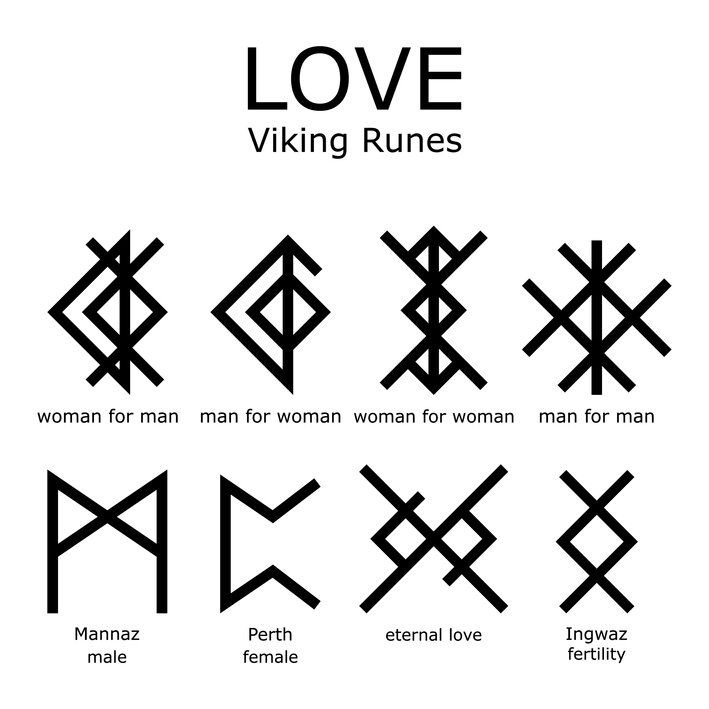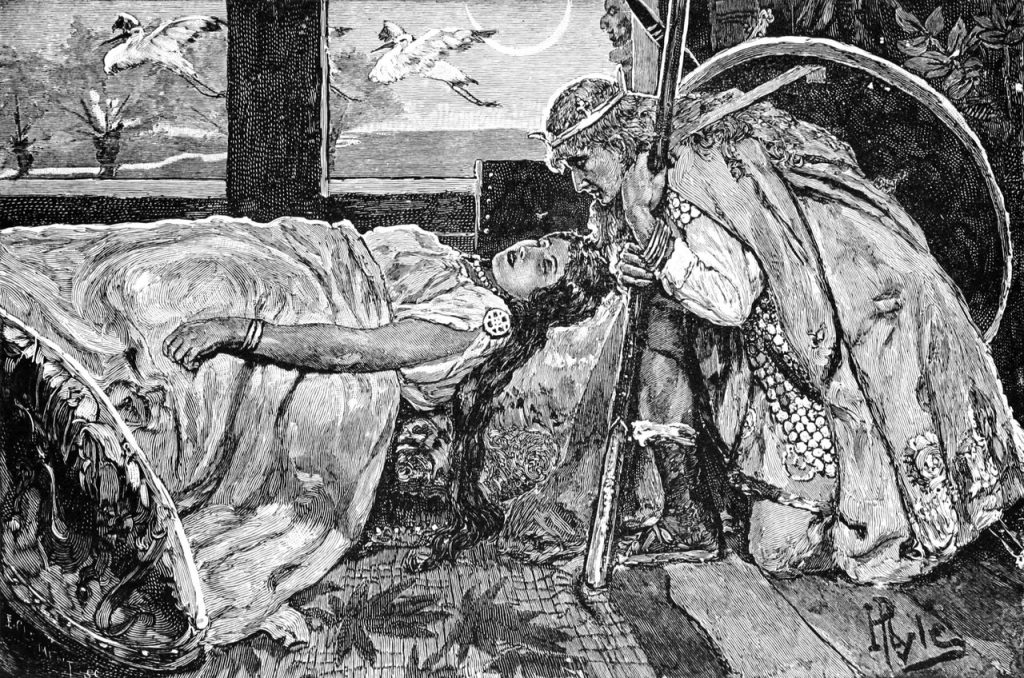With great mythology come heroic tales, and a recurring theme in such tales is love. Old Norse mythology is no different and contains many love stories, many of them tragic.
Whether it’s Sigurd and Brunhilde or Freyr and Gerðr, tales of love, betrayal, and death are never far away when looking through Norse literature.
The principal Norse god, Odin and Frigg were man and wife but seemed to have a troubled marriage. They were allegations and hints of unfaithfulness on both sides, and they seemed to take great pleasure in sniping at each other.
The Concept Of Love In Viking Culture
Family life was meaningful in Ancient Scandinavian culture, and most Viking-age men and women intended to marry and have children. Arranged marriages were common in Scandanavian life at those times.
Both sexes could initiate divorce proceedings citing neglect, physical abuse, or adultery as common reasons. Old Nordic social customs were ahead of their time, and some influences are still evident today.
The Viking Goddess Of Love Freyja
Freyja is the daughter of Njord, ruler of the realm of Vanaheim. Freyja was the most famous goddess in Viking society, along with Frigg. Not only was she the masterful practitioner of a kind of magic called seiðr, but she was also the Norse goddess of love, fertility, beauty, sex, gold, and, strangely, war.
Freyja’s powers are typical of Vanir gods: gentle and related to agriculture, magic, and love. She had two daughters with her husband, Óðr: Gersemi and Hnoss.
However, she is also the ruler of Fólkvangr, the field of the fallen. Fólkvangr was similar to Valhalla as a resting place for warriors fallen in battle.
Ironically, Freyja’s marriage was not perfect. Óðr liked to wander so much that Freyja gave herself the name Mardöll (or “she who shines over the sea”) whenever she went out searching for her husband.
What Is The Viking Rune For Love?

There are symbols representing the love of a man towards a woman and vice versa. There are also signs for the love of a man towards a man and a woman towards a woman, showing that homosexuality and lesbianism were recognized and tolerated by Viking society to a certain extent.
What Did Vikings Call Their Lovers?
The word for “lover” in Old Norse was friðill.
“Ást” is “love” (the noun). However, “I love you” in modern Icelandic is “Ég elska þig”. In Old Norse, it was “ek ann þér” or “ek elska þik.”
According to a post on Tumblr, in Norse myth, men didn’t say “ek ann þér” or “ek elska þik”, they said “Þú getur lyft hammanum mínum hvenær sem er, ef þú veist hvað ég meina”, roughly translated as “You are my Valkyrie, and I would follow you across the nine realms and into eternity.”
The Most Famous Love Stories In Norse Mythology
Freyr and Gerðr
Freyr fell in love with the giantess jotunn Gerðr (or Gerd) after she lit up the entire world on their first meeting. However, he had to relinquish his magic sword to become her husband.
In the poem Skírnismál from the Poetic Edda, Freyr sent his servant Skirnir (or Skírnir) to Jotunheim to manage his courting of the giant goddess, daughter of Gymir. Skírnir agreed if Freyr gave him his magic sword as a reward.
The giantess refused the servant’s requests until he used his magic wand to convince her. Without his magic sword to help him, Freyr had to improvise in a fight with the jötunn Beli and kill him with an antler. During Ragnarök, he was unsuccessful in his battle with Surtr, the fire giant. Without his magical sword, Surtr defeated and killed Freyr.

Svipdagr and Mengloth
Svipdagr appears in two poems from Svipdagsmál contained in the Poetic Edda, Grógaldr and Fjölsvinnsmál.
Svipdagr’s stepmother sent him to search for his appointed bride, Menglöð. Having no idea where she was, he raised his mother, Gróa, a völva (or sorceress), from the dead to help him. Gróa cast nine spells (a significant number in Norse mythology) which lead Svipdagr to a castle guarded by a gatekeeper and hound-keeper called Fjölsviðr (an alias used by Odin in Grímnismal).
Fjölsviðr asked Svipdagr his name to which he replied, “Vindkald.” The gatekeeper would only let Svipdagr pass if he beat him in a game of 18 riddles. Fjölsviðr asked him questions about the castle, its residents, and its surroundings, finally revealing that he would only open the gates to a man called Svipdagr. Svipdagr revealed his true identity and was allowed to pass.
He found Menglöð inside and proved to her who he really was:
Svipgdag I am named,
Svipdagr – Pantheon Org
Solbiart was my father named;
thence the winds on the cold ways drove me.
Urd’s decree
may no one gainsay,
however lightly uttered.

Sigurd and Brunhilde
The Prose Edda and the Poetic Edda have separate versions of Sigurd and Brunhilde’s tragic love stories.
Attestation in the Prose Edda
The Islandic politician, historian, and poet Snorri Sturluson wrote the Prose Edda, and his version of the most famous Brunhilde story is similar, although shorter, to the one found in the Poetic Edda in theVöluspá:
Siegfried (or Sigurd) is returning from a tremendous adventure in which he killed Fáfnir, a dwarf that transformed into a dragon, and Fáfnir’s brother, Regin. Regin was a master smith who had made Siegfried a magical sword called Gram.
He had convinced Siegfried to kill Fáfnir so he could reclaim a share of a trove of golden treasure, including a ring called Andvaranaut that Loki had stolen from another dwarf named Andvare. Loki had undertaken this theft to pay back a debt he owed to Hreidmar, the father of Fáfnir and Regin.
While riding home with the gold, he found a maiden asleep in a house. She was wearing a helmet and imprisoned in a coat of mail, which he cut from her using Gram.
The Sorceress Grimhilde
She awoke and told him her name was Brunhilde, and she was a Valkyrie. He fell in love with her on the spot and promised to return and make her his wife. He left the castle and went to the court of his king Gjuke (or Gjuki) of Burgundy. Siegfried told the court about his adventures and how he intended to return to Brunhilde and marry her.
However, Gjuke’s wife, the sorceress Grimhilde, wished Siegfried to marry her daughter, Gudrun, instead and concocted a magic potion to make Siegfried forget all about Brunhilde. Siegfried married Gudrun, and instead, Grimhilde decided that Brunhilde would make a good wife for one of her sons, Gunnar.
As brothers-in-law, Siegfried had entered a blood-oath with Gunnar and another brother, Hogne. Consequently, he accompanied Gunnar to the home of Atle (or Atli), Brunhilde’s brother, for Gunnar to ask for Atle’s sister’s hand in marriage.
They found out Brunhilde had fallen into an everlasting sleep inside a house surrounded by a raging ring of fire called the Vafurloge. Odin created this curse after she had resolved a disagreement between two kings but had not supported the one that Odin favored.
Atli told the brothers that Brunhilde could only marry someone capable of riding through the flames.

Gote and Grane
Gunnar tried to ride his horse Gote through the fire, but the horse refused. Grane, Siegfried’s horse, was much braver but would only allow Siegfried to ride him. The only solution was for Siegfried to disguise himself as Gunnar by shapeshifting so Brunhilde would think it was Gunnar passing through the fire. He achieved this magical feat as he was still under the influence of the sorceress.
Siegfried, passing himself off as Gunnar, rode through the flames and wed Brunhilde that night, presenting her with the gold ring called Andvaranaut – Brunhilde gave him a gold ring in return. However, he did not consummate the marriage, placing Gram between them as they lay in the marriage bed for the next three nights.
Siegfried, still as Gunnar, left on the third morning and, once out of Brunhilde’s sight, shapeshifted back into himself. Siegfried gave the gold ring to Gudrun when he returned home.
Sometime later, Brunhilde, now living at the court with Gunnar, was washing her hair in the river next to Gudrun. Brunhilde commented that she did not wish Gudrun to use the same river water as her and told her to stand further downstream.
The Final Revelation
Brunhilde said that Gudrun was not worthy of using the same water as her husband, Gunnar, was a braver man than Gudrun’s husband Siegfried. Gudrun responded by telling Brunhilde how Siegfried had slain Fáfnir and Regin and brought back a hoard of gold. Brunhilde laughed and said that was nothing compared to the courage Gunnar had shown by riding through the Vafurloge.
At this, Gudrun revealed that it had been Siegfried, transformed into Gunnar, who had passed through the raging fire and showed Brunhilde the ring she had given “Gunnar” after their wedding. She also correctly identified the ring Andvaranaut Brunhilde wore on her finger, giving precise details about how Siegfried had come about it.
Enraged, Brunhilde convinced Gunnar and Hogne to kill Siegfried but being blood brothers to him, they could not. After persuading another brother, Guthorm, to commit the act, Siegfried killed him with Gram, cutting him in two. However, Guthorm had succeeded in surprising Siegfried as he slept, mortally wounding him. Siegfried’s child of only three also died in the attack, and some sources named Brunhilde as the assassin.
Still, in love with Siegfried, she committed suicide by flinging herself onto his burning funeral pyre. Other accounts have her killing herself with Gram and being cremated on the same pyre as Siegfried.
Fictional Tales of Love In Norse Mythology
Donna Jo Napoli (1948-?) is an American children’s fiction writer and an eminent linguist. She wrote a novel called Treasury of Norse Mythology: Stories of Intrigue, Trickery, Love, and Revenge, published by National Geographic in 2013.
She takes a fictional look at the folk and fairy tales of ancient Scandinavia involving Asgard, Valhalla, and the Æsir gods Odin, Thor, and Loki. This work is the third in a series of books that also looks at Egyptian and Greek mythology.

